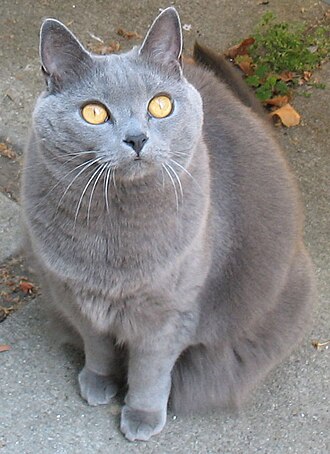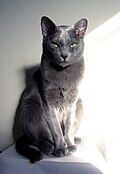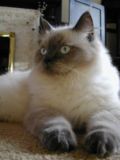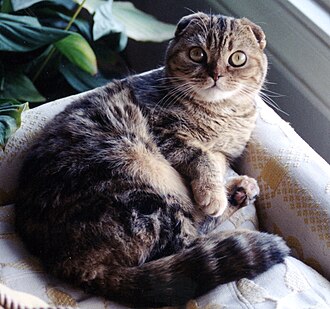Difference between revisions of "AY Honors/Cats - Advanced/Answer Key"
| Line 49: | Line 49: | ||
===d. The Scottish Fold breed dates back to 1961. True or False: This cat acquired its name because it folds its body up to stay warm.=== | ===d. The Scottish Fold breed dates back to 1961. True or False: This cat acquired its name because it folds its body up to stay warm.=== | ||
[[Image:Scottish Fold.jpg|thumb|Scottish Fold]] | [[Image:Scottish Fold.jpg|thumb|Scottish Fold]] | ||
| + | False. | ||
| + | |||
The Scottish Fold is a breed of cat with a natural mutation to its ears. The ear cartilage contains a fold so the ears bend forward and down towards the front of their head. | The Scottish Fold is a breed of cat with a natural mutation to its ears. The ear cartilage contains a fold so the ears bend forward and down towards the front of their head. | ||
| Line 58: | Line 60: | ||
There is one medical problem that has been found to be related to Scottish Fold breeding. If both parents have folded ears, their kittens will be extremely prone to developing a painful degenerative joint disease that fuses the tail, ankles and knees. This condition also affects Scottish folds with one copy of the fold gene, to a lesser degree, and is the reason the breed is not accepted by the Governing Council of the Cat Fancy and the Fédération Internationale Féline. | There is one medical problem that has been found to be related to Scottish Fold breeding. If both parents have folded ears, their kittens will be extremely prone to developing a painful degenerative joint disease that fuses the tail, ankles and knees. This condition also affects Scottish folds with one copy of the fold gene, to a lesser degree, and is the reason the breed is not accepted by the Governing Council of the Cat Fancy and the Fédération Internationale Féline. | ||
| + | |||
===e. One breed was developed from a type of cat which once roamed the streets of Singapore. Now called the Singapura, it is also known by which one of the following names?=== | ===e. One breed was developed from a type of cat which once roamed the streets of Singapore. Now called the Singapura, it is also known by which one of the following names?=== | ||
====(1) Drain cat==== | ====(1) Drain cat==== | ||
Revision as of 02:24, 1 June 2007
1 Have the basic Cat Honor.
2. Know about cats "open-book" quiz. (This is not an instructional pass-a-test requirement, it is designed to encourage research into the world of cats.) Enjoy new discoveries as you research the following questions about some unusual domestic cat breeds from around the world.
a. The domestic cat known as Sphynx first appeared in the late 1960s. Which of the following is true about this Canadian breed?
(1) It is too wild to be a proper house cat.
(2) It is the national pet of Canada.
(3) It appears to be hairless.
The Sphynx (aka Canadian Hairless) is a rare breed of cat with extremely little fur, or at most a short fuzz over its body, and no, or very short and stiff whiskers. Their skin is the color their fur would be, and all the usual cat marking patterns (solid, point, van, tabby, tortie, etc) may be found in Sphynx too. They are sometimes mistaken for Chihuahuas because of their extremely unusual and, some say, uncatlike appearance. They are extremely intelligent, extroverted, and affectionate, often cuddling with their owners, other humans, and each other.
b. True or False: The Chartreux, with its brilliant orange eyes and blue lips, is a breed closely associated with France.
True.
The Chartreux is an internationally recognized breed of domestic cat from France. There is a legend that the Chartreux are descended from cats brought to France by Carthusian monks to live in the order's head monastery, the Grande Chartreuse, located in the Chartreuse Mountains north of the city of Grenoble (Siegal 1997:27). But in 1972, the Prior of the Grande Chartreuse denied that the monastery's archives held any records of the monks' use of any breed of cat resembling the Chartreux (Simonnet 1990:36–37). Legend also has it that the Chartreux's ancestors were feral mountain cats from what is now Syria, brought back to France by returning Crusaders in the 13th century, many of whom entered the Carthusian monastic order. The first documented mention of the breed was by the French naturalist Buffon in the 17th century. The breed was largely decimated during the first World War and wild populations were not seen after World War Two. A concerted effort by European breeders kept the breed from extinction. The first Chartreux were brought to the USA in 1971 by Helen and John Gammon of La Jolla, California. There are fewer than two dozen active Chartreux breeders in North America as of 2007.
c. Match the following cats with the special characteristics of their breed:
| (1) Korat (Thailand) | (a) Goes limp when picked up. |
| (2) Ragdoll (USA) | (b) Is traced to wild cats from Kenya. |
| (3) Sokoke (Denmark) | (c) Symbolizes good fortune. |
Korat
The Korat is one of the oldest stable breeds of cat. Originating in Thailand, it is named after the Nakhon Ratchasima province, although in Thailand it is often known as Si-Sawat, which means good fortune. In fact they are often known colloquially as the "Good Luck Cat" and are given in pairs to newlyweds or people of high esteem as a wish for good luck.
The first known written mention of the Korat was in "The Cat-Book Poems" authored between 1350 and 1767 AD in Thailand, now preserved in the National library in Bangkok. They first appeared in America in the 1950s and arrived in Britain from there in 1972.
Korats are a shorthair with a small to medium build and a low percentage of body fat; their bodies are often described as semi-cobby, and are surprisingly heavy for their size. They are an active cat and form strong bonds with people.
Korats have several characteristics that together distinguish them as a breed:
- Korats are one of a few breeds that have only one colour.
- Jean Johnson first introduced Korats to the US in 1959. She had lived in Thailand, where she first encountered the breed. Her first pair were named Nara (male) and Dara (female).
Ragdoll
The Ragdoll is a breed of medium longhaired cat. It is best known for its docile and placid temperament and affectionate nature. They are non-aggressive to the point that many cats cannot or should not be let outside for prolonged periods as many will not defend themselves and most do not hunt. The name "Ragdoll" derived from the fact that many of these cats go completely limp and relax when picked up. Ragdolls have a sturdy body, short legs, and a thick coat with Siamese-style points.
Sokoke
The original name of the breed was Khadzonzos. The Khadzonzos cats were discovered in the Arabuko-Sokoke forest, on the Kenyan coast, by Jeni Slater in 1978. Gloria Moeldrop, a friend of Slater's, brought some of the cats home with her to Denmark to breed. In 1990, she imported more cats from Kenya to strengthen the breeding stock. The cats were first shown in Copenhagen in 1984. The breed was officially recognized by the FIFe in 1993, with the name changed to Sokoke, after the place from whence they came.
Sokokes have blotched tabby coats in shades of brown, with amber to light green eyes. Their coats are short and coarse, with little to no undercoat. Their bodies are long and thin, with long legs. The back legs should be longer than the front legs, similar to an ocelot. Sokokes are very active and enjoy climbing and "talking" to their people.
d. The Scottish Fold breed dates back to 1961. True or False: This cat acquired its name because it folds its body up to stay warm.
False.
The Scottish Fold is a breed of cat with a natural mutation to its ears. The ear cartilage contains a fold so the ears bend forward and down towards the front of their head.
The original Scottish Fold was a long-haired white-haired barn cat named Susie, who was found at a farm near Coupar Angus in Perthshire, Scotland in 1961. Susie's ears had an unusual fold in their middle, making her resemble an owl. When Susie had kittens, two of them were born with folded ears, and one of the siblings was acquired by William Ross, a neighboring farmer and cat-fancier. Ross registered the breed with the Governing Council of the Cat Fancy in Great Britain and started to breed Scottish Fold kittens with the help of geneticist Pat Turner. The breeding program produced 76 kittens in the first three years - 42 with folded ears and 34 with straight ears. The conclusion from this was that the ear mutation is due to a simple dominant gene. If one parent provides the gene for straight ears, and one parent provides the gene for folded ears, the kittens will be Folds.
The breed was not accepted for showing in Great Britain and Europe as it was felt that they would be extremely prone to ear problems such as infection, mites and deafness, but the folds were exported to America and the breed continued to be established there using crosses with British Shorthair and the American Shorthair.
Scottish Folds can be either long or short-haired, and they may have any coat color combination except for Siamese-style points. Pointed Folds have been bred but they are not eligible for showing. The original cats only had one fold in their ears, but due to selective breeding they have increased the fold to a double or triple crease that causes the ear to lie totally flat against the head. Scottish Folds, whether with folded ears or with normal ears, are typically good-natured and placid, and are known for sleeping on their backs. They tend to become very attached to their human caregivers and are by nature quite affectionate. Scottish Folds typically have soft voices and display a complex repertoire of meows and purrs not found in better-known breeds.
There is one medical problem that has been found to be related to Scottish Fold breeding. If both parents have folded ears, their kittens will be extremely prone to developing a painful degenerative joint disease that fuses the tail, ankles and knees. This condition also affects Scottish folds with one copy of the fold gene, to a lesser degree, and is the reason the breed is not accepted by the Governing Council of the Cat Fancy and the Fédération Internationale Féline.





